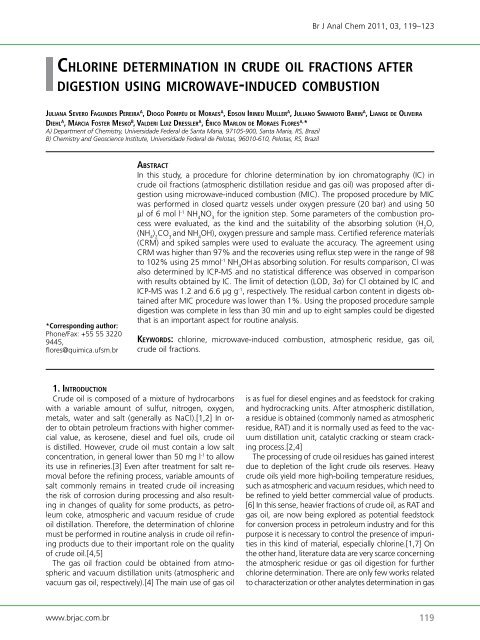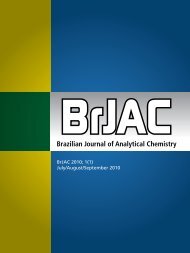Brazilian Journal of Analytical Chemistry - BRJAC - Brazilian Journal ...
Brazilian Journal of Analytical Chemistry - BRJAC - Brazilian Journal ...
Brazilian Journal of Analytical Chemistry - BRJAC - Brazilian Journal ...
Create successful ePaper yourself
Turn your PDF publications into a flip-book with our unique Google optimized e-Paper software.
Ch l o r i n E d E t E r m i n a t i o n in CrudE o i l f r a C t i o n s a f t E r<br />
d i g E s t i o n u s i n g m iC r o w a v E-i n d u C E d C o m B u s t i o n<br />
Ju l i a n a sEvEro fa g u n d E s PE rE i ra A , di o g o Po m P é u d E mo ra E s A , Ed s o n ir i n E u mullEr A , Ju l i a n o sm a n i o t o Ba r i n A , li a n g E d E olivEira<br />
di E h l A , má rC i a fostEr mEsko B , va l d E r i lu i z drEsslEr A , ériCo ma r l o n d E mo ra E s fl o rE s A, *<br />
A) Department <strong>of</strong> <strong>Chemistry</strong>, Universidade Federal de Santa Maria, 97105-900, Santa Maria, RS, Brazil<br />
B) <strong>Chemistry</strong> and Geoscience Institute, Universidade Federal de Pelotas, 96010-610, Pelotas, RS, Brazil<br />
*Corresponding author:<br />
Phone/Fax: +55 55 3220<br />
9445,<br />
flores@quimica.ufsm.br<br />
www.brjac.com.br<br />
aBstraCt<br />
In this study, a procedure for chlorine determination by ion chromatography (IC) in<br />
crude oil fractions (atmospheric distillation residue and gas oil) was proposed after digestion<br />
using microwave-induced combustion (MIC). The proposed procedure by MIC<br />
was performed in closed quartz vessels under oxygen pressure (20 bar) and using 50<br />
µl <strong>of</strong> 6 mol l -1 NH 4 NO 3 for the ignition step. Some parameters <strong>of</strong> the combustion process<br />
were evaluated, as the kind and the suitability <strong>of</strong> the absorbing solution (H 2 O,<br />
(NH 4 ) 2 CO 3 and NH 4 OH), oxygen pressure and sample mass. Certified reference materials<br />
(CRM) and spiked samples were used to evaluate the accuracy. The agreement using<br />
CRM was higher than 97% and the recoveries using reflux step were in the range <strong>of</strong> 98<br />
to 102% using 25 mmol -1 NH 4 OH as absorbing solution. For results comparison, Cl was<br />
also determined by ICP-MS and no statistical difference was observed in comparison<br />
with results obtained by IC. The limit <strong>of</strong> detection (LOD, 3σ) for Cl obtained by IC and<br />
ICP-MS was 1.2 and 6.6 µg g -1 , respectively. The residual carbon content in digests obtained<br />
after MIC procedure was lower than 1%. Using the proposed procedure sample<br />
digestion was complete in less than 30 min and up to eight samples could be digested<br />
that is an important aspect for routine analysis.<br />
kE y w o r d s: chlorine, microwave-induced combustion, atmospheric residue, gas oil,<br />
crude oil fractions.<br />
1. in t r o d u C t i o n<br />
Crude oil is composed <strong>of</strong> a mixture <strong>of</strong> hydrocarbons<br />
with a variable amount <strong>of</strong> sulfur, nitrogen, oxygen,<br />
metals, water and salt (generally as NaCl).[1,2] In order<br />
to obtain petroleum fractions with higher commercial<br />
value, as kerosene, diesel and fuel oils, crude oil<br />
is distilled. However, crude oil must contain a low salt<br />
concentration, in general lower than 50 mg l -1 to allow<br />
its use in refineries.[3] Even after treatment for salt removal<br />
before the refining process, variable amounts <strong>of</strong><br />
salt commonly remains in treated crude oil increasing<br />
the risk <strong>of</strong> corrosion during processing and also resulting<br />
in changes <strong>of</strong> quality for some products, as petroleum<br />
coke, atmospheric and vacuum residue <strong>of</strong> crude<br />
oil distillation. Therefore, the determination <strong>of</strong> chlorine<br />
must be performed in routine analysis in crude oil refining<br />
products due to their important role on the quality<br />
<strong>of</strong> crude oil.[4,5]<br />
The gas oil fraction could be obtained from atmospheric<br />
and vacuum distillation units (atmospheric and<br />
vacuum gas oil, respectively).[4] The main use <strong>of</strong> gas oil<br />
Br J Anal Chem 2011, 03, 119–123<br />
is as fuel for diesel engines and as feedstock for craking<br />
and hydrocracking units. After atmospheric distillation,<br />
a residue is obtained (commonly named as atmospheric<br />
residue, RAT) and it is normally used as feed to the vacuum<br />
distillation unit, catalytic cracking or steam cracking<br />
process.[2,4]<br />
The processing <strong>of</strong> crude oil residues has gained interest<br />
due to depletion <strong>of</strong> the light crude oils reserves. Heavy<br />
crude oils yield more high-boiling temperature residues,<br />
such as atmospheric and vacuum residues, which need to<br />
be refined to yield better commercial value <strong>of</strong> products.<br />
[6] In this sense, heavier fractions <strong>of</strong> crude oil, as RAT and<br />
gas oil, are now being explored as potential feedstock<br />
for conversion process in petroleum industry and for this<br />
purpose it is necessary to control the presence <strong>of</strong> impurities<br />
in this kind <strong>of</strong> material, especially chlorine.[1,7] On<br />
the other hand, literature data are very scarce concerning<br />
the atmospheric residue or gas oil digestion for further<br />
chlorine determination. There are only few works related<br />
to characterization or other analytes determination in gas<br />
119



